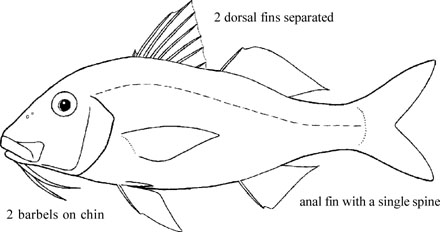MULLIDAE
Goatfishes
By Ukkrit Satapoomin
|
Parupeneus heptacanthus |
 Upeneus tragula |
|
Body moderately elongate and somewhat compressed (size to 50 cm). Mouth low on head; lower jaw inferior; two long unbranched barbels on chin; a single flat spine posteriorly on opercle; margin of preopercle smooth. Two well-separated dorsal fins, the first with VII - VIII slender spines; the second fin with 9 soft rays (first unbranched); anal fin with I spine and 6 - 7 soft rays; caudal fin deeply forked; pectoral fins with 13 - 18 soft rays; pelvic fins with I spine and 5 soft rays. Scales finely ctenoid; lateral line complete, following the contour of back, with 27 - 38 pored scales. Color: ground color often whitish to light red; most species with distinctive black, brown, red, or yellow markings; median fins often with stripes or oblique bands.
Similar families occurring in the area. Polymixiidae: the only other family with a pair of long barbels on chin; the species occur in deep water, about 200 - 400 m. They are distinguished from the Mullidae by the following combination of characters: a single, unnotched dorsal fin with IV - VI spines; anal fin with III - IV spines; barbels inserted well behind tip of lower jaw. Remarks: Inhabit shallow seas, on open sand or mud bottoms. They are carnivorous, feeding on a wide variety of small animals, especially crustaceans and worms. The barbels, with chemosensory receptors, are actively moved over or into the sediment to find food organisms. The family name derived from Latin, mullus = soft. |

|
|